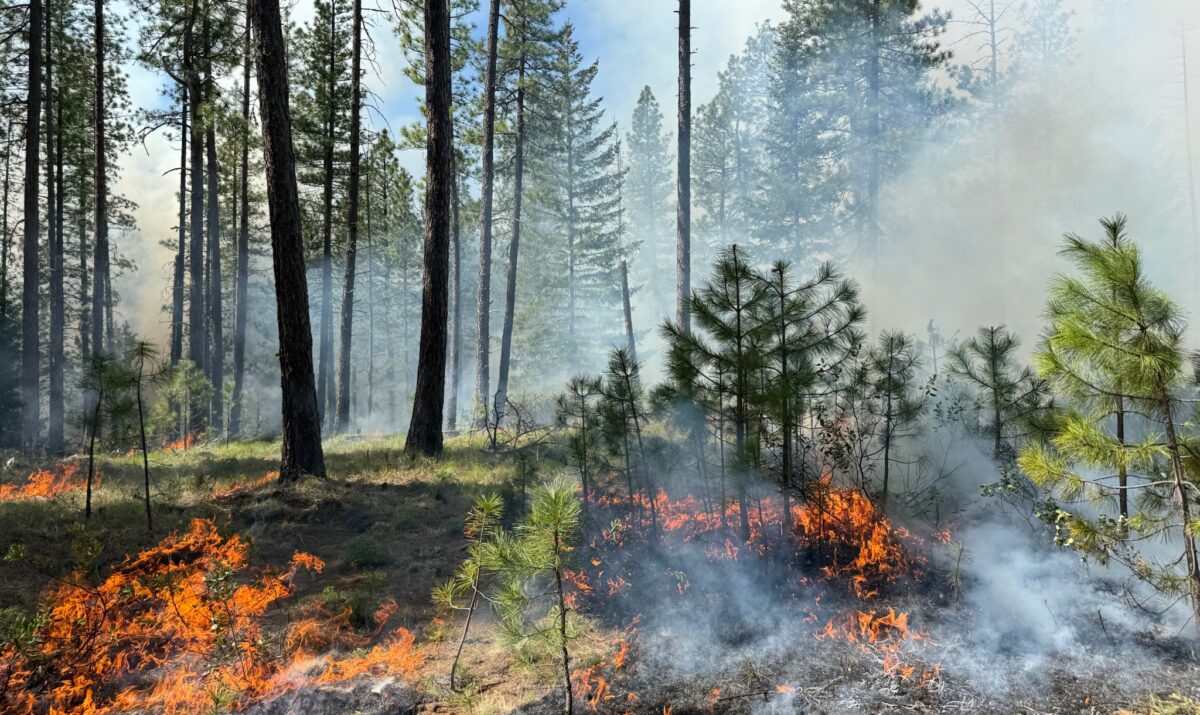Rx Fire: An Art and a Science
A second prescribed burn at Bear Creek builds on work to restore ecological integrity

Early on a crisp, spring morning in a ponderosa pine forest, red-breasted nuthatches called out to each other high in the canopy of mature trees, the water in Bear Creek babbled, the smell of pine sap filled the air, and the snow-covered summit of Mount Adams peeked through the trees. For a couple hours, this peaceful setting turned into a bustling, yet highly organized prescribed burn operation. Nuthatch chatter was temporarily joined by radio chatter, the sound of Bear Creek was overtaken by the crackle of burning wood, and the smell of pine sap turned into the smell of a campfire. The forest came alive in a whole different way.
In May we completed a second successful prescribed burn within our Bear Creek stewardship unit, located near the Klickitat River outside Glenwood, Washington. This burn site covered about 15 acres just south of where we completed a previous broadcast burn in fall 2023. (https://www.columbialandtrust.org/goodfire/) (See photos from a year after the 2023 burn here: https://www.columbialandtrust.org/good-fire-improves-forest-health/)
With the adjacency of this year’s burn to the one completed in 2023 we will be able to observe some differences between spring and fall burns.
“Bear Creek is home to extensive dry ponderosa pine woodlands that were previously managed as industrial forests. Prior to industrial forest management, frequent, low-severity fires maintained open and patchy pine savanna conditions. Well planned and executed broadcast burning is one of the most important restoration tools we have to build resilience and restore ecological integrity to this landscape,” said Natural Area Manager Adam Lieberg.
A late spring day brought warm temperatures and low wind, which make for good burn conditions.
“Before the burn there was a thick layer of organic material – leaves and needles – on the ground, and a lot of small ponderosa pines and thickets of young Douglas fir,” said Lieberg. “The objective was to reduce the amount of duff and needle litter, as well as the smaller diameter trees that developed in the absence of low-intensity fire.” Removing these smaller trees frees up growing space, moisture, and nutrients for the remaining, larger trees, improving their ability to withstand future drought, wildfire, and insects.
We also wanted to knock down the ceanothus, a large shrub, from overtaking the understory. In the absence of frequent, low-intensity fires, Ceanothus and other small trees increase ladder fuels, which allow fires to climb up from the ground into the crowns of larger trees, contributing to risk of severe, high-intensity crown fires.” Ceanothus in particular, while providing important forage for wildlife, burns very hot and can contribute to wildfire severity.
This burn was conducted with local partners from Mt Adams Resource Stewards, Skookum Resource Management, and the Mt Adams Prescribed Burn Association.
“This felt really successful,” said East Cascades Oak Partnership Manager Lindsay Cornelius. “These are complex operations, Everything, including people and equipment, has to be in the right place at the right time. This burn was well-organized and conditions were ideal. I’m excited to see how ecological effects manifest over the next year.”
Following this burn, we could immediately observe desired effects. During a wildfire, smaller trees and shrubs can carry flames up and into the crowns of larger trees, increasing the intensity and impact of the fire (we call these fuels “ladder” fuels). The Bear Creek burn removed ladder fuels across 15 acres, lowering the risk of future high severity wildfire. The prescribed fire also consumed the top layer of needles and leaves (called duff) on the forest floor. These natural materials also act as fuel in a wildfire so skimming them off the ground during low-intensity controlled burns gives plant roots an opportunity to respond to changes in duff depth by growing deeper into the ground where they are better insulated from fire. The removal of duff also lowers the temperatures of future fires by removing fuels that are available to burn.
“It is surprising how much heat six inches of leaves and needles can generate,” said Cornelius, “… it’s enough to kill mature trees. Burning these fuels bit by bit is an incredibly hopeful kind of stewardship.”
Just a few days after the prescribed burn, life continues in the forest. The sound of red-breasted nuthatches is accompanied by the excited chatter of red crossbills, yellow-rumped warblers, pine siskins, robins, and numerous other birds gathered to feast on the bounty of insects aroused by the recent low-intensity fire. A turkey chimes in with a gobble. A bear walks down the recently dug control line, leaving tracks and scat letting us know he’s still here. The babble of Bear Creek continues to create the soothing white noise it always has. And through the charred black surface of the forest floor, native forbs and grasses are peeking out as vibrant as can be, reminding us that fire is part of life in the East Cascades.
Photos:
1/9: Low-intensity fire clears understory duff and saplings.
2/9: The burn team facilitates and monitors the fire.
3/9: Removing smaller trees improves health and drought-resistance of larger trees.
4/9: Ensuring the fire is extinguished.
5/9: On the left is the unit that was burned in fall 2023, and on the right is the recent burned area.
6/9: A woodland strawberry sprout, following the burn.
7/9: A balsamroot sprout, following the burn.
8/9: The understory in the burn unit now has reduced ladder fuels, that could have resulted in higher intensity wildfire.
9/9: Bear tracks walking along the control line after the burn.